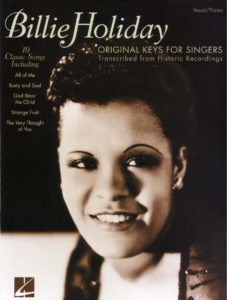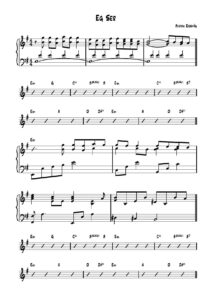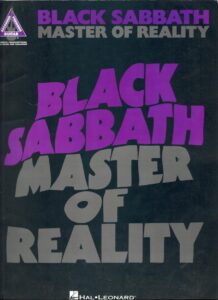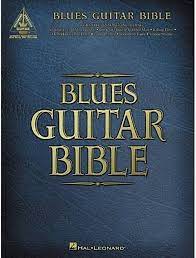Table of Contents
Wave – Vou Te Contar Jobim sheet music (guitar)

TOM JOBIM
Brazilian songwriter and vocalist Antonio Carlos Jobim (1927–1994) was one of the creators of the subtle, whispery, jazz-influenced popular song style known as bossa nova. He has been widely acclaimed as one of Brazil’s greatest and most innovative musicians of the twentieth century.
Jobim’s place in the annals of popular music was secured by a single hit song, “The Girl from Ipanema” (1964), which he co-wrote with lyricist Vinícius de Moraes. His creative contributions to jazz, however, went much deeper; many of his songs became jazz standards, and, in the words of Richard S. Ginell of the All Music Guide , “Every other set” performed in jazz clubs “seems to contain at least one bossa nova.”
Jobim was sometimes called the George Gershwin of Brazil, not so much because of any musical or lyric similarity—Jobim’s songs tended to have oblique, often poetic lyrics quite unlike the clever romantic rhymes of George Gershwin’s brother Ira—but because his music became the bedrock for the work of jazz musicians for decades after its creation.
Studied with German Music Teacher
Antonio Carlos Brasileiro de Almeida Jobim, often known by the nickname Tom, was born in Rio de Janeiro on January 25, 1927. He grew up in the seaside southern Rio suburb of Ipanema, later the setting for his most famous song, and many of his compositions reflected Brazil’s lush natural world in one way or another. Both of Jobim’s parents were educators, and his father, Jorge Jobim, was also active as a diplomat.
But Jobim took after an uncle who played classical guitar, and he soon showed unusual talent of his own. Jobim’s mother, Nilza, rented a piano for the family home, and when Jobim was 14 he began piano lessons with Hans Joachim Koellrutter, a local music scholar of German background who favored the latest experimental trends in European classical music.
Please, subscribe to our Library.
If you are already a subscriber, please, check our NEW SCORES’ page every month for new sheet music. THANK YOU!
Jobim would later point to the influence exerted by French Impressionist composers Claude Debussy and Maurice Ravel on his own music, but a new set of influences was on its way to Brazil in the form of American jazz. Jobim enrolled in architecture school, lasted less than a year, and worked as an assistant to a local architect in the early 1940s.
His real energies were directed toward music, as he gained experience playing piano in small nightclubs known as inferninhos , or little infernos. Visits to Rio by the Duke Ellington Orchestra and other American jazz bands shaped Jobim’s own attempts at composition (which he buried in a drawer at first) and inspired him to settle on a musical career. In 1949 he married his first wife, Thereza Hermanny; they raised a son, Paulo, and a daughter, Elisabeth.

With his well-rounded musical education, by the early 1950s Jobim was able to graduate from Rio’s bars to staff arranging positions with the Continental and Odeon record labels. At this point Jobim was working in the genre of samba, Brazil’s national pop song style, and he sometimes performed his own samba compositions.
His real breakthrough came about in 1956, as the result of a chance meeting two years earlier with Brazilian playwright Vinícius de Moraes. Moraes was working on a play called Orfeu da Conceicção , which was later filmed as Orfeu Negro (Black Orpheus). The play and film transferred the classic Greek myth of Orpheus and Eurydice to modern-day Rio de Janeiro, and Moraes suggested that Jobim write the music for it.
The film Orfeu Negro became an international success, and Jobim’s score, featuring guitarist Luiz Bonfá, kicked off a new musical craze that quickly spread beyond Brazil. It was based in samba rhythms, but it featured subtle harmonic shadings drawn from jazz.
The new style was given the name bossa nova, meaning “new wave,” and the 1958 single “Chega de Saudade” (No More Blues), with music by Jobim, words by Moraes, and guitar by future Brazilian pop star João Gilberto, was the style’s first major hit. Both “Chega de Saudade” and the flip side of the original single, Jobim’s composition “Desafinado” (Out of Tune), have remained jazz standards.
Performed in New York
Jobim’s star rose quickly in Brazil after the release of “Chega de Saudade.” He continued to record with Gilberto, began hosting a weekly television show called O Bom Tom , and wrote music in which he drew on his classical background for the soundtrack to a film called Por Toda a Minha Vida and (with Moraes) Brasîlia, Sinfonia da Alvorada , a four-movement orchestral work with text.
By 1962 American jazz musicians had begun to immerse themselves in bossa nova. Jobim sang his “Samba de uma nota só” (One-Note Samba) on an album by Gilberto and jazz flutist Herbie Mann. The bossa nova phenomenon reached the United States as saxophonist Stan Getz and guitarist Charlie Byrd recorded their successful Jazz Samba album, and in November of 1962 Jobim and other Brazilian musicians performed a major bossa nova concert at New York’s Carnegie Hall. The show was the idea of a Brazilian diplomat who wanted to promote the country’s musical accomplishments abroad.
Best Sheet Music download from our Library.
The concert initially seemed to be a flop. The Brazilian players were thrown off their stride by New York’s miserable late fall weather, and critics panned the show. Jobim and his compatriots also took criticism from Brazilian observers who felt they were diluting Brazilian music by singing songs in English—Jobim, who spoke several languages, sometimes translated his own songs from Portuguese into English, while others were translated by jazz writer Gene Lees. Nevertheless, the Carnegie Hall concert succeeded in exposing Jobim to American musicians and music industry figures.

Jobim recognized the importance of American exposure in broadening the reach of his music, and he quipped that if he had remained in Brazil, he would still just be drinking beer in Rio’s corner bars. In 1963 he made his U.S. recording debut on the Verve label with The Composer of Desafinado Plays.
Jobim followed up that release with several more albums in a smooth jazz vein. He collaborated with one of his most influential American admirers on a successful 1966 release, Francis Albert Sinatra & Antonio Carlos Jobim , which was seldom if ever out of print during the next four decades. Jobim sang, played piano, and occasionally strummed a guitar on these recordings, often backed by a small orchestra.
In 1962 Jobim composed a song that was soon to become a worldwide phenomenon, and in the process he added a phrase to the international lexicon. “The Girl from Ipanema” (in Portuguese, “Garota de Ipanema”) was written as Jobim and Moraes were sitting at a table in a bar in Jobim’s hometown of Ipanema and became infatuated with a passer-by, the “tall and tan and young and lovely” woman described in the song. With a vocal by Gilberto’s wife, Astrud, and a verse of English lyrics, the song became a number-two hit in the United States in 1964, eclipsed only by the Beatles’ “A Hard Day’s Night.”
Jobim prospered, although he was never canny about the music publishing deals he signed, and he often failed to receive a proper share of the money his songs earned.
Jobim’s total output of albums was not large (he recorded ten solo albums, plus nine more with collaborators), but his music remained consistently successful through much of the 1960s.
Nothing else became a hit on the scale of “The Girl from Ipanema,” but such songs as “Wave,” “Insensatez” (How Insensitive), and “Meditation,” with vocals by Jobim himself, Astrud Gilberto, or other singers, became part of the record collections of many sophisticates, and were internalized by jazz musicians as quickly as they appeared. Jobim maintained a strong following in Brazil, thanks to duets recorded with female vocalist Elis Regina, and his 1968 album A Certain Mr. Jobim reached the top 15 on Billboard magazine’s jazz sales chart in the United States.
Branched Out Beyond Bossa Nova
Jobim’s popularity dipped in the 1970s as bossa nova finally ran out of steam commercially, but he never really slowed down creatively. One of his most widely covered songs of the decade was 1972’s “Aguas de Março,” which Jobim himself translated into English (with added lyrics) as “Waters of March”; the English version almost completely avoided words with roots in Romance languages (such as Portuguese) in favor of those of Germanic origin. The lyrics consisted of a seemingly disconnected series of images that suggested the impermanence of life.
The influential jazz critic Leonard Feather, according to Mark Holston of Americas , placed “Waters of March” “among the top ten songs of all time.” Jobim recorded with Brazilian-born arranger Eumir Deodato on his Stone Flower album of 1970, and he also often worked with German-born arranger Claus Ogerman. Jobim’s 1975 album Urubu (meaning “The Vulture”) reflected his personal fascination with that bird of prey.
In 1976 Jobim met 19-year-old photographer Ana Beatriz Lontra; the pair had a son, João Francisco, in 1979, married in 1986, and had a daughter, Maria Luiza Helena, in 1987. In the late 1970s Jobim was active mostly in film soundtracks, but in 1984 he assembled his Nova Banda or New Band, with his son Paulo on guitar, and began touring once again.
His concerts in the United States in the mid-1980s were in venues with the highest profiles: Carnegie Hall and Avery Fisher Hall in New York, and Constitution Hall in Washington. His 1987 release Passarim was as well received in the jazz community as any of his 1960s releases had been, and selections from it appeared on several posthumous collections of his work.
Critics by this time recognized Jobim as a living legend, and he received various awards of national and international scope in the last years of his life. These included the Diploma of Honor, the highest arts award given by the Organization of American States, which he received in 1988, and induction into the Songwriters’ Hall of Fame in 1991.
Jobim never rested on his laurels, and he entered the mid-1990s with a full plate of creative projects. He worked with classical conductor Ettore Stratta in preparing recordings of some of his more classical-oriented works, and he planned to record an album with opera star Kathleen Battle. In 1994 Jobim released a new album, Antonio Brasileiro , and rejoined Frank Sinatra for a track on Sinatra’s Duets II release.
With these career capstones in the works, it came as a shock for Jobim’s admirers in both the United States and Brazil when Jobim died suddenly of heart failure at New York’s Mount Sinai Hospital on December 8, 1994, shortly after entering the facility for treatment of cardiac disease. Jobim’s body was returned to Brazil, where a funeral parade held in his honor in Rio de Janeiro lasted for four hours, and he was buried in a tomb near that of Vinícius de Moraes, who had died in 1980.
The pair had created two of the icons of twentieth-century culture, Black Orpheus and “The Girl from Ipanema,” and the music that came from Jobim’s pen lent the music of much of the century’s second half a distinct Brazilian tinge.
Browse in the Library:
| Artist or Composer / Score name | Cover | List of Contents |
|---|---|---|
| Billie Eilish Lovely With Khalid |
 |
|
| Billie Eilish Wish You Were Gay Lu |
 |
|
| Billie Eilish – Bad Guy Sheet Music Piano solo |
 |
|
| Billie Eilish – Dont Smile At Me Songbook (Billie Eilish) Piano Vocal Guitar |
 |
Billie Eilish – Dont Smile At Me Songbook (Billie Eilish) Piano Vocal Guitar contents |
| Billie Eilish – Happier Than Ever Piano vocal guitar (Billie Eilish) |
 |
Billie Eilish – Happier Than Ever Piano vocal guitar (Billie Eilish) |
| Billie Eilish – Therefore I Am Sheet Music Piano vocal Guitar chords |
 |
|
| Billie Eilish – What Was I Made For Billie Eilish piano solo arr. from Barbie OST | Billie Eilish – What Was I Made For Billie Eilish piano solo arr. 1st page | |
| Billie Eilish – What Was I Made For easy piano with lyrics from Barbie OST | Billie Eilish – What Was I Made For easy piano-with lyrics 1st page | |
| Billie Eilish Copycat |
 |
|
| Billie Eilish For Beginning Piano Solo (Billie Eilish) |
 |
Billie Eilish For Beginning Piano Solo (Billie Eilish) |
| Billie Eilish ilomilo (Piano Solo) |
 |
|
| Billie Eilish My Boy |
 |
|
| Billie Holiday – John Szwed The Musician and the Myth (Book) |
 |
|
| Billie Holiday – The Songbook (piano-vocal-guitar chords) |
 |
Holiday, Billie – The Songbook |
| Billie Holiday Diana Ross Songbook |
 |
Billie Holiday Diana Ross Songbook |
| Billie Holiday Songbook |
 |
BILLIE HOLIDAY SONGBOOK |
| Billy Elliot – Electricity |
 |
|
| Billy Elliot Vocal Score |
 |
Billy Elliot Vocal Score |
| Billy Idol – Guitar Songbook | Billy Idol – Guitar Songbook | |
| Billy Joel – A Collection Of Songs |
 |
Billy Joel A Collection Of Songs |
| Billy Joel – Best Of Piano Solos | Billy Joel – Best Of Piano Solos | |
| Billy Joel – Greatest songs (Piano & Voice) |
 |
BILLY JOEL – GRATEST SONGS (PIANO & VOICE) |
| Billy Joel – Just the way you are |
 |
|
| Billy Joel – Just The Way You Are as performed by Diana Krall) Sheet Music Piano Vocal Guitar Chords | Billy Joel – Just The Way You Are as performed by Diana Krall) Sheet Music Piano Vocal Guitar Chords | |
| BILLY JOEL – PIANOMAN | BILLY JOEL PIANOMAN | |
| Billy Joel – Root Beer Rag | ||
| Billy Joel – Shes Always A Woman | ||
| Billy Joel – The Words And Music of – by Ken Bielen (Book) |
 |
|
| Billy Joel – Uptowngirl | ||
| Billy Joel Complete Volume 1 (Piano vocal Guitar sheet music) |
 |
Billy Joel Complete Volume 1 (Piano vocal Guitar sheet music) |
| Billy Joel Complete Volume 2 (Piano vocal Guitar sheet music) |
 |
Billy Joel Complete Volume 2 (Piano vocal Guitar sheet music) |
| Billy Joel Fantasies And Delusions (solo piano) |
 |
|
| Billy Joel Favorites Keyboard Book (Billy Joel) |
 |
Billy Joel Favorites Keyboard Book (Billy Joel) |
| Billy Joel Rock Score |
 |
|
| Billy Joel The Keyboard Book |
 |
Billy Joel Keyboard Book  |
| Billy Preston – best of, Piano & Vocal songbook |
 |
Billy Preston – best of Piano & Vocal songbook |
| Billy Ray Cyrus – Old Town Road [Remix] Sheet Music |
 |
|
| Billy Strayhorn Chelsea Bridge |
 |
|
| Billy Strayhorn Lotus Blossom Transcription As Played By Duke Ellington In 1967 |
 |
|
| Billy Strayhorn Lush Life songbook Vol 66 |
 |
Billy Strayhorn Lush Life songbook Vol 66 |
| Billy Strayhorn Satin Doll | Billy Strayhorn Satin Doll | |
| Billy Strayhorn Take The A Train | Billy Strayhorn Take The A Train | |
| Billy Strayhorn Take The A Train arranged for Piano by Billy Strayhorn |
 |
Billy Strayhorn Take The A Train Full Score |
| Billy Taylor Modern Jazz Piano Solos |
 |
|
| Billy Taylor The Jazz Life Of Dr. Billy Taylor (Billy Taylor Teresa L. Reed) Book |
 |
|
| Birdland Joe Zawinul Arr Semton Barlas – Full concert band |
 |
|
| Birdy – Piano Vocal Songbook |
 |
 |
| Birth Of The Blues, The Jimmy Lally sheet music |
 |
|
| Bizet Georges – Habanera (From The Opera Carmen) Piano Solo Arr. (Musescore File).mscz | ||
| Bizet – Marche Des Rois Easy Piano |
 |
|
| Bizet, Georges Habanera (From The Opera Carmen) Piano Solo Arr. |
 |
|
| Bjork – Bachelorette |
 |
|
| Bjork – Hunter Sheet Music |
 |
|
| Bjork – Joga |
 |
|
| Bjork – Oh so quiet |
 |
|
| Bjork – Unravel |
 |
|
| Bjorn Eidsvag Eg Ser Piano Solo sheet music |
 |
|
| Black – Wonderful Life (Piano and vocal sheet music) |
 |
|
| Black – Wonderful Life (Piano And Vocal Sheet Music) (Musescore File).mscz | ||
| Black Eyed Peas Don’t Lie Transcription By Deusde Coppen |
 |
|
| Black Eyed Peas Shut Up Transcription By Deusde Coppen |
 |
|
| Black Orpheus ( “Manha de Carnaval” or “A Day in the Life of a Fool”) Luis Bonfá | Black Orpheus | |
| Black Orpheus (Manha De Carnaval) Jazz Lead sheet | Black Orpheus(Manha De Carnaval) | |
| Black Sabbath – Guitar Signature Licks (Guitar Songbook) |
 |
Black Sabbath – Guitar Signature Licks (Guitar Songbook) |
| Black Sabbath Guitar Songbook |
 |
Black Sabbath Guitar Songbook |
| Black Sabbath Master Of Reality Guitar tab with lyrics |
 |
Black Sabbath Master Of Reality Guitar tab with lyrics |
| Black Sabbath Paranoid Guitar Songbook |
 |
Black Sabbath Paranoid Guitar Songbook |
| Blackbeauty – Baby Beauty – Danny Elfman | ||
| Blackbeauty – Main Theme – Danny Elfman | ||
| Blackpink – How You Like That | Blackpink – How You Like That | |
| BlackPink – Play with Fire (Piano Solo sheet music) |
 |
|
| Blade Runner – Love Theme (piano) |
 |
Blade_Runner_-_Love_Theme |
| Blade Runner – Love Theme Vangelis (arr. For Keyboard) |
 |
|
| Blade Runner – Love Theme Vangelis (For Keyboard) (Musescore File).mscz | ||
| Blake Neely – How To Play From A Fake Book Keyboard Edition Faking Your Own Arrangements From Melodies and Chords |
 |
Blake Neely – How To Play From A Fake Book KeyboardBlake Neely – How To Play From A Fake Book Keyboard |
| Blessings Arr Phillip Keveren The Phillip Keveren Series Piano Solo |
 |
Blessings Arr Phillip Keveren The Phillip Keveren Series Piano Solo |
| Blind Guardian – The Eldar | ||
| Blink 182 – All The Small Things | ||
| Bliss Concerto For Piano And Orchestra |
 |
|
| Bloch, Ernest Ten Pieces For Children For Piano Enfantines |
 |
Bloch, Ernest Ten Pieces For Children For Piano Enfantines |
| Blondie Anthology |
 |
Blondie Anthology |
| Blondie The Best Of – Piano vocal Guitar chords songbook |
 |
Blondie The Best Of – Piano vocal Guitar chords songbook |
| Blowing In The Wind – Bob Dylan (Harmonica And Guitar) With Sheet Music (Musescore File).mscz | ||
| Blue – Breathe Easy | ||
| Blue Bossa (Jazz Piano Solo) Kenny Dorham |
 |
|
| Blue Bossa Piano – by Kenny Dorham |
 |
|
| Blue Mitchel When the Saints go marching in (solo transcription) |
 |
|
| Blue Mitchell – Blue Soul Solo Transcription |
 |
|
| Blue Mitchell – Love Solo Transcription | Blue Mitchell – Love Solo Transcription | |
| Blue Moon | Blue Moon | |
| Blue Moon – Joe Pass (Musescore File).mscz | ||
| Blue Moon – R. Rodgers – Piano Interpretation by George Shearing | Blue Moon – R. Rodgers – PIano Interpretation by George Shearing | |
| Blue Moon (Jazz Standard) Guitar Tablature TABs |
 |
|
| Blue Moon (Musescore File).mscz | ||
| Blue Moon (Rodgers & Hart) Piano sheet music |
 |
|
| Blue train (Jazz solo) | ||
| Blues & Soul Christmas (piano, guitar & vocal songbook) |
 |
Blues & Soul Christmas |
| Blues And Boogie Pour Piano Thierry Masson |
 |
Blues And Boogie Pour Piano |
| Blues And Jazz Preludes For Classical Guitar by Alexander Vinitsky |
 |
Blues And Jazz Preludes For Classical Guitar by Alexander Vinitsky |
| Blues Bass Play Along Trax (Guitar) |
 |
|
| Blues Fake Book, The |
 |
Blues Fake Book, The |
| Blues Guitar – Guitar Method -by Greg Koch (lessons and 20 great blues songs) (with Tablature) |
 |
|
| Blues Guitar (Classic) Jam With Songbook. With Mp3 Audio Tracks Play Along |
 |
Blues Guitar (Classic) Jam With Songbook. With Mp3 Audio Tracks Play Along |
| Blues Guitar Basics by Keith Wyatt |
 |
|
| Blues Guitar Bible 35 Great Blues Songs (Guitar with TABs) |
 |
Blues Guitar Bible 35 Great Blues Songs (Guitar with TABs) |
| Blues Guitar Collection with Tablature by Scott Henderson |
 |
Blues Guitar Collection with Tablature by Scott Henderson |
| Blues Guitar For Dummies (eBook) |
 |
|
| Blues Guitar Play Along Vol. 7 with audio MP3 with Tablature |
 |
Blues guitar play along |
| Blues Guitar, The Anthology of (by Woody Mann) |
 |
Blues Guitar, The Anthology of (by Woody Mann) |
| Blues Hanon – Theory Development Application by Leo Alfassy |
 |
Blues Hanon – Theory Development Application by Leo Alfassy |
| Blues In F Joey Alexander Feat. Wynton Marsalis Sextet Jazz In Marciac 2015 sheet music transcription |
 |
|
| Blues Keyboard – Around Midnight – 14 Blues Pour Piano |
 |
Blues Keyboard |
| Blues Piano Gustavo Villegas (Spanish- Español) |
 |
Blues.Piano |
| Blues Piano For Beginners by Mark Harrison |
 |
Blues Piano For Beginners by Mark Harrison |
| Blues Piano Keyboard arr. Michat Kirkoff |
 |
|
| Blues Piano Legends |
 |
Blues Piano Legends |
| Blues Play A Long And Solos Collection For Piano Beginner series by Andrew D. Gordon |
 |
Blues Play A Long And Solos Collection For Piano by Andrew D Gordon |
| Blues Riffs For Piano by Ed Baker (Great Riff series) |
 |
|
| Blues Rock for Classical Guitar | Blues Rock for Classical Guitar | |
| Blues To Jazz GuitarThe Essential by Jack Eskridge The essential guide to chords, progressions and theory |
 |
